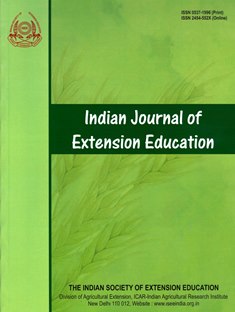Bottlenecks in Adoption of Agroforestry Practices in Jammu Division of Jammu and Kashmir
DOI:
https://doi.org/10.48165/IJEE.2023.59110Keywords:
Agro-forestry, Resources, Adoption, Bottlenecks, LivelihoodAbstract
Agro-forestry is an excellent medium of land utilization for obtaining the maximum output. In both irrigated and rain-fed environments, agroforestry is practised to produce food, fuel, fodder, timber, fertiliser, and fibre. It also contributes to nutritional and ecological security, supports livelihoods, reduces poverty, and encourages resilient and productive cropping and farming environments. Adoption of different practices of agro forestry systems is very much crucial for sustaining the livelihood of resource poor farmers particularly in rainfed area. The present study was carried out in 10 blocks of Jammu district of Jammu and Kashmir in 2018 to identify different bottlenecks encountered by farmers in adoption of different agro-forestry practices. Multistage random sampling method was used for selection of 160 respondents from study area. The results show lack of awareness, lack of structural market and lack of interactions with respective governmental organizations were the major bottlenecks in adoption of different agro forestry practices for sustainable livelihood generation.
Downloads
References
Anderson, G. W., Moore, R. W., & Jenkins, P. J. (1988). The integration of pasture, livestock and widely-spaced pine in South West Western Australia. Agroforestry systems, 6(1), 195-211.
Anonymous. (2015). Vision 2050. Central Agro-forestry Research Institute, Jhansi, India.
Arnold, J. E., & Dewees, P. (1998). Rethinking approaches to tree management by farmers. Natural Resource Perspectives, 26, 1- 14.
Bharat, Chapke, R. R., & Kammar, S. (2022). Farmers’ perception about climate change and response strategies. Indian Journal of Extension Education, 58(1), 7-11.
Chundawat, B. S., & Gautam, S. K. (1993). A Textbook of Agroforestry, New Delhi. Oxford & IBH publishing, Co. Pvt. Ltd. Chuskey, R., Singh, K. C., Singh, C., & Birle, Y. (2021). Adaptation of farmers regarding climate resilient technologies in Rewa Block of Rewa District in Madhya Pradesh. Indian Journal of Extension Education, 57(1), 26-31.
Das, B., Dhakar, M. K., Sarkar, P. K., Kumar, S., Nath, V., Dey, P., Singh, A. K., & Bhatt, B. P. (2017). Performance of mango (Mangifera indica) based agri-horticultural systems under rainfed plateau conditions of eastern India. Indian Journal of Agricultural Sciences, 87(4), 521-527.
Das, B., Naik, S. K., Sarkar, P. K., Singhal, V., Arunachalam, A., Acharyya, G., Borah, D., Kumar, J., Shukla, G., & Bhatt, B. P. (2016). Agroforestry for livelihood security in Eastern India. ICAR- RC for Eastern Region, Patna. 109 p.
Das, B., Sarkar, P. K., Kumari, N., Dey, P., Singh, A. K., & Bhatt, B. P. (2019). Biophysical performance of different multipurpose trees species in Jharkhand, India. Current Science, 116(1), 82- 88.
Doyle, C. J., Evans, J., & Rossiter, J. (1986). Agroforestry: an economic appraisal of the benefits of intercropping trees with grassland in lowland Britain. Agricultural Systems, 21(1), 1-32.
Garforth, C. J., Malla, Y. B., Neopane, R. P., & Pandit, B. H. (1999). Socioeconomic factors and agro-forestry improvements in the hills of Nepal. Mountain Research and Development, 19, 273- 278.
Iqbal, T., Slathia, P. S., Peshin, R., Sehgal, S., Sharma, M., Kour, K., Kumar, R., & Kumar, P. (2022). Livelihood generation through participation in joint forest management programme. Journal of Community Mobilization and Sustainable Development, 17(3), 963-968.
Islam, M. A., Masoodi, T. H., Gangoo, S. A., Sofi, P. A., Bhat, G. M., Wani, A. A., Gatoo, A. A., Singh, A., & Malik, A. R. (2015). A Perceptions, attitudes and preferences in agroforestry among rural societies of Kashmir, India. Journal of Applied and Natural Science, 7(2), 976-983.
Naik, B. H., Singh, A. K., & Maji, S. (2022). Constraints in adoption of climate resilient agricultural technologies in Telangana. Indian Journal of Extension Education, 58(4), 163-165.
Nair, P. K. R. (1993). An introduction to Agroforestry. Department of Forestry, University of Florida, Gainesville, Florida, U.S.A., 489 p.
Nair, P. K. R., & Dagar, J. C. (1991). An approach to developing methodologies for evaluating agroforestry systems in India. Agroforestry Systems, 16(1), 55-81.
Ngambeki, D. S. (1985). Economic evaluation of alley cropping Leucaena with maize and maize-cowpea in southern Nigeria. Agricultural Systems, 17, 243–258.
Pathania, A., Chaudhary, R., Samriti, Sharma, S., & Kumar, K. (2020). Farmer’s perception in the adoption of agroforestry practices in low hills of Himachal Pradesh. Indian Journal of Agroforestry, 22(2), 101-104.
Saravanan, S., & Berry, N. (2021). Agroforestry practices in Tamil Nadu, India – a boon for farmers for livelihood security. Current Science, 120(4), 644-653.
Sarkar, P. K. (2019a). CO2 FIX model: A tool for estimating carbon sequestration potential of any agroforestry system. Agriculture & Food: e-Newsletter, 1(3), 61-66.
Sarkar, P. K. (2019b). Improving livelihood through agarwood (Aquilaria malaccensis Lam.) based agroforestry systems: an option. Agriculture & Food: e-Newsletter, 1(6), 139-147.
Sarkar, P. K., Das, B., & Bhatt, B. P. (2017). Bakain (Melia azedarach L.): a promising agroforestry species for improving livelihood to farmers of Eastern plateau and hill region of India. The Bioscan, 12(2), 1095-1100.
Shekhawat, J. S., Sen, N. L., & Somani, L. L. (1988). Evaluation of agro-forestry systems under semi-arid conditions of Rajasthan. Indian Forester, 114(2), 98-101.
Sood, K. K. (2006). The Influence of household economics and farming aspects on adoption of traditional agroforestry in Western Himalaya. Mountain Research and Development, 26, 124-130.
Srivastava, B. P., & Pant, M. M. (1979). Social forestry on a cost benefit analysis framework. Indian Forester, 105(1), 2-35. Verchot, L. V., Van Noordwijk, M., Kandji, S., Tomich, T., Ong, C., Albrecht, A., & Palm, C. (2007). Climate change: linking adaptation and mitigation through agro-forestry. Mitigation and Adaptation Strategies for Global Change, 12(5), 901-918.
Downloads
Published
Issue
Section
License

This work is licensed under a Creative Commons Attribution-NonCommercial-NoDerivatives 4.0 International License.

